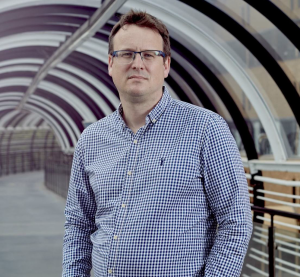OICR’s Dr. Jared Simpson developed a world-first application for Oxford Nanopore sequencing that is making a difference for patients with brain cancer.
When Dr. Jared Simpson developed the first-ever software to detect DNA methylation using the Oxford Nanopore Technologies sequencing platform in 2017, he knew there was huge potential for cancer research.
Measuring DNA methylation — a process associated with cancer where a cell’s function is changed due chemical ‘tagging’ — had already proven helpful in classifying different types of cancers.
And Nanopore sequencing — an affordable, portable and faster alternative to traditional genome sequencing platforms — had widely recognized potential to make to sequencing easier and more accessible.
But what Simpson couldn’t have known in 2017 was that his software would help launch a series of advancements that has culminated in a UK hospital now using Nanopore sequencing to classify brain tumour types in real time in the operating room.
“We knew our method was state-of-the-art, and that it would be useful for cancer research and hopefully for cancer patients,” says Simpson, Scientific Director and Senior Principal Investigator of Computational Biology at OICR. “But what it has become, with this application to classify brain cancer in a clinical setting, is absolutely amazing.”
Nanopore sequencing is a relatively new technology. It reads larger chunks of DNA at one time and more quickly than traditional “short read” sequencers do. While the per-run cost of Nanopore sequencing is slightly higher than short-read sequencers, the machinery itself is significantly less expensive.
By 2017, Nanopore technology had advanced to the point where it could process enough data to sequence a human genome, while remaining small enough to sit on a desktop. So, the time was right for Simpson and colleagues to apply this new sequencing technology to DNA methylation.
“We knew it was possible, but we had to figure out how to train machine learning models,” Simpson recalls. “Importantly, we also wrote software that anyone could use to predict methylation from Oxford Nanopore sequencing data.”
They published their work in a 2017 Nature Methods paper and made their software package available with open access. In the years since, their software was used by several research teams studying DNA methylation and became widely recognized as the gold standard in the field.
The software was of particular interest to researchers studying brain cancer, which has dozens of molecular subtypes that can be diagnosed using methylation and are critical to determining the best ways to treat a tumour. The speed and accuracy of Simpson’s software on the Nanopore sequencing platform allowed researchers to explore quicker, more effective tools to diagnose brain cancer subtypes that could ultimately be used to guide treatment.
Simpson’s software laid the groundwork for further advancements to Nanopore sequencing methods, including a 2023 Nature study that used a newer deep-learning based method to detect methylation for ultra-fast classification of brain tumour types.
Then early in 2025, a team led by Dr. Matthew Loose of the University of Nottingham (UK) took a major step forward in the use of Nanopore to classify brain tumours. Loose and colleagues’ advanced software allows all necessary brain tumour subtyping tests to be combined into one assay performed on Nanopore, cutting the time it takes to accurately diagnose brain tumours from a few weeks to a few hours.
The process is so quick that, during trials at a Nottingham hospital, some tumours were sampled and sequenced within the same surgery, allowing doctors to make surgical decisions based on the results.
“What we are seeing is that clinicians obtain results faster, patients can move to the appropriate treatment and care pathways faster and patient uncertainty is reduced,” Loose says.

This groundbreaking clinical application of Nanopore has the potential to transform how brain cancers are diagnosed, providing patients with quicker results that can be actioned sooner and give them the best chance at surviving cancer. It builds on years of work, much of which was enabled by Simpson’s 2017 innovation.
“Jared’s early work…was foundational to the translational applications we are now developing with Nanopore sequencing,” Loose says.
For Simpson, whose lab is largely focused on developing computational methods and software to understand cancer, it’s gratifying to see his work making a difference in the clinic.
“This direct clinical application to classify people’s brain cancer within the operation room — that’s very exciting and confirmation that what we do is having an impact on patients,” Simpson says.
As sequencing technology continuing to advance, Simpson sees even more exciting clinical applications on the horizon. His lab is now using Nanopore sequencing to find cancer DNA in blood samples — tests that are often referred to as ‘liquid biopsies’, and have been shown to detect cancer earlier than imaging and other existing tests.
“Nanopore is cheap, portable and increasingly more accurate,” Simpson says, “and so it could help bring important genomic testing to hospitals and healthcare centres across Ontario.”


